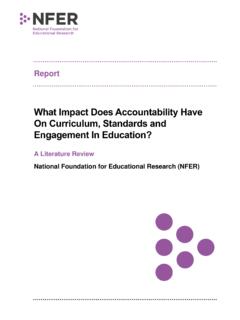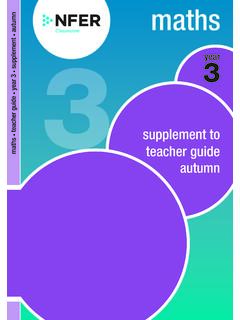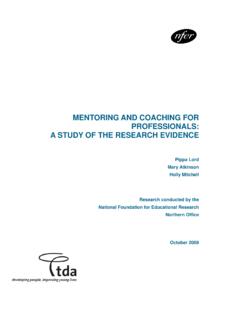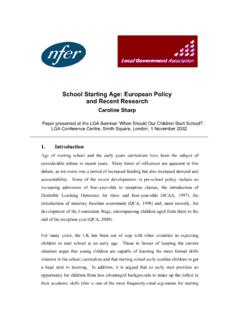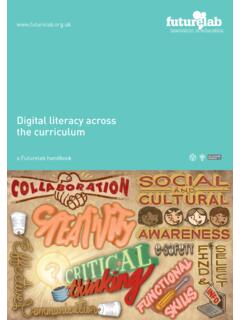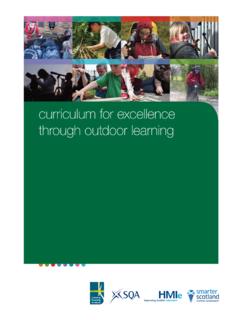Transcription of Learner engagement: a review of learner voice initiatives ...
1 Learner ENGAGEMENTA review of Learner voice initiatives across the UK s education sectorsLeila Walker, Senior Researcher, Futurelabwith Ann Logan, Educational Consultant 2008 ContentsPreface 1 Section 1: Introduction to Learner engagement and Learner voice Defining Learner engagement and Learner voice 2 Learner voice drivers 2 What is genuine Learner voice ? 4 Developing Learner voice 5 Value of technologies in Learner voice engagement 6 Section 2: Current landscape of Learner voice initiatives Different types of Learner voice 8 What methods are being used to develop Learner voice engagement? 8 What enables Learner voice to develop in schools? 13 What enables Learner voice to develop in further and higher education? 14 Section 3: Case studies Primary schools 15 Secondary schools 19 Further education and higher education 24 Section 4: The use of digital technologies in Learner voice initiatives Benefits of using digital technologies 30 Enhancing practice 31 Current Learner voice practice involving technologies 32 Section 5: Evidence of Learner voice activity from public and third sector organisations Who is involved and what part are they playing?
2 43 How to make the best use of the third sector? 46 Section 6: Directory of references and resources Research on Learner voice 47 Resources 47 Websites 49 Policy documents 52 Bibliography 54 Footnotes January 2007, Becta (British Educational Communication and Technology Agency) commissioned Futurelab to carry out a meta- review of current Learner voice activity across primary, secondary, further and higher education. Desk-research and expert interviews inform the main corpus of this report. In addition, a workshop with practitioners, researchers and technologists was held to update information regarding the potential use of technology in Learner voice would like to acknowledge the following people for providing insights into Learner voice activities across practice, policy and academia: Sue Attards, Sara Bragg, Nell Banfield, Alex Bols, Martin Brennan, Anna Craft, Lynn Davies, Matthew Dean, Peter Ferne, Clare Fox, Sarah Fletcher, Su Garlick, Richard Gentle, Adrian Gray, Carl Greenham, Roz Hall, Diane Hallas, Julia Hayes, James Hartley, Andrew Hudson, Peter Humphreys, Michele Innis, Asher Jacobsberg, Alex Jones, Jo Lee, Clara Lemon, Jack Lewars, Matt Little, Gill Mullis, Philippa Newby, Sean O Sullivan, Tom Reed, Tim Riches, Luke Rodgers, Ros Smith, Dan Sutch, Dan Tagg, Hugh Thomas, Maggie Thomas, Peter Twining, Ed purpose of this report is to provide educators working within primary, secondary, further and higher education with a guide to how Learner voice is currently being used to shape policy and practice in education.
3 Case studies have been chosen to illustrate the potential impact Learner voice can make across the UK s education sectors. Although the case studies provided are from different sectors we would encourage readers to explore the methods and activities used in each, as these may offer new perspectives that you may wish to consider in your own context. In addition, the report discusses how digital technology may be used to advance Learner voice initiatives by enabling greater Learner -driven practice, as well as engaging all learners, particularly those who are typically under-represented. The main aims of this report are:To summarise the evidence from research, policy and _practice for the promotion of Learner voice engagement across the primary, secondary, further (FE) and higher (HE) sectors of highlight current Learner voice practice and the need _to enhance the outline the potential role of digital technologies to _empower all learners to have their provide useful guidance on developing Learner voice provide a directory of resources to engage Learner _voice across the education audience of this report is likely to be headteachers, college principals and practitioners as well as academic registry officers and local authority education advisors.
4 Defining Learner engagement and Learner Learner voice What is genuine Learner voice ? Developing Learner Value of digital technologies in Learner voice Defining Learner engagement and Learner voice For engaged learning to happen, the [learning space] must be conceived of as a knowledge-building learning community. Such communities not only develop shared understandings collaboratively but also create empathetic learning environments that value diversity and multiple perspectives. These communities search for strategies to build on the strengths of all of its members. Fletcher (2005)Research increasingly suggests that when learners are engaged in shaping and leading their own learning and education this can result in benefits for all learners, educators , the institution and the education system as a whole (eg Davies et al 2007). In particular, the benefits for learners who are involved are said to include:greater sense of ownership over their learning _increased motivation _improved self-esteem _greater achievement _improved relationships with peers and educators _increased self-efficacy.
5 _At the same time, failure to engage with learners in the education process risks increasing disengagement and disillusion amongst learners with their educational experiences. There is also a risk that education will become one of the few areas of social life in which core communities and consumers of a service remain unconsulted. Learners are part of a community and the best way of empowering communities is to listen to them and act upon their views. When people have a voice and an influence on decisions and outcomes they are more likely to participate and also to learn through is a range of definitions that embrace the concept of Learner voice , including: How students come to play a more active role in their a direct result of their [ educators ] becoming more attentive, in sustained or routine ways, to what students want to say about their experience of learning. Hargreaves (2004) It should be noted that in most studies the concept of Learner voice is referred to as student voice or pupil voice .
6 For the purpose of this report we shall be using the term Learner voice to encourage debate on who the Learner actually is, as today, the student (both adult and young), the teacher or even their parents are now often referred to as learners whose voices should be heard and acted upon. However, to date, the greater share of this field has focused upon students in Learner voice activity so this report and the case studies it presents, reflect this current Learner voice driversThe call to engage learners in the whole process of their education is not new: To teach is to learn twice. 1 Joseph Joubert (1782) The greatest lessons in life, if we would stoop and humble ourselves, we would learn not from grown-up learned men, but from the so-called ignorant children. 2 Mahatma Gandi (1931)Section 1: Introduction to Learner engagement and Learner When adults think of students, they think of them as potential beneficiaries of change. They rarely think of students as participants in a process of change and organisational life.
7 3 Michael Fullan (2001)What is new is the importance policy and practice communities are now placing upon Learner voice as a key agent for greater Learner engagement. Since 2002 the Education Act requires all schools to consult with students for example, Ofsted expects inspectors to report on the degree to which schools seek and act upon the views of learners (Ofsted, July 2005), and the recently introduced Self-Evaluation Form (SEF) specifically asks: What are the views of learners, parents/carers and other stakeholders and how do you know? Learner voice has appeared explicitly in recent UK policy promoting personalised learning with agendas around school improvement such as Every Child Matters (DfES 2006) being at the forefront of this new Learner -driven improvement practice. In addition, the current National Healthy Schools Standard4 sets out as one of its elements a whole-school approach to give children and young people a say. Furthermore, the House of Commons Education and Skills Committee (2007), having published a report investigating citizenship education, has recommended that every school should have a school council.
8 In summary, the key drivers in statutory education that are influencing Learner voice initiatives are:children s rights _active citizenship _school improvement _personalisation agenda. _What is noteworthy is that for many commentators in education, the drive towards personalised learning came from concerns that significant numbers of learners were refusing to attend school, let alone aspire to further education or training these youngsters were (and are) using their feet to express their voice about their unhappiness with current schooling. Perhaps, this is our strongest example of how Learner voice has driven educational policy and practice in recent , the suggestion that Learner voice should be a major vehicle for driving through the above education agendas has been greeted with concern from some quarters of the education community. The potential burden that Learner voice mechanisms may add to already busy learning establishments has been aired with most union leaders not in favour of mandatory councils.
9 Therefore, the guidance of good practice that this report hopes to offer will be in the context of concerns and barriers from stakeholders working in educational institutions. The government has shown a recent commitment to guiding schools, and more recently post-16 institutions, through documents such as: DfES (2004) Working Together: giving children and young people a say (revised version due April 2008); DfES (2005) Higher Standards, Better Schools for All; and the LSC s (2007) FE handbook Developing a Learner Involvement Strategy . This change is a product partly of the legal changes which have acknowledged the rights of children and partly of the increasing number of educators who are witnessing the benefits of consulting learners about the issues that directly and indirectly benefit them in their learning institutions and beyond. Both perspectives are clarified in Article 12 of the UN Convention of the Rights of the Child: Parties shall assure to the child who is capable of forming his or her own views the right to express those views freely in all matters affecting the child, the views of the child being given due weight in accordance with the age and maturity of the child.
10 Article 12, United Nations Convention on the Rights of the should be noted that most change has occurred in education sectors serving statutory-aged learners. However, this Learner -driven culture is increasingly witnessed in institutions working with non-statutory-aged learners in further education Since Sept 2007, all post-16 education providers are requested to have a Learner Involvement Strategy . This is part of a wider programme of change and personalisation within FE to ensure that provision meets the needs of students. to the primary and secondary sectors, lead drivers for Learner voice in Further Education include:personalised learning agenda _active citizenship . _Other drivers also include: Foster review _LSC s Framework for excellence and Learner _involvement strategyQIA Improvement strategy. _Since September 2007, all post-16 colleges must have:a Learner Involvement Strategy _a student committee _a mechanism for engaging learners collectively _two student governors and a Staff Student Liaison _Officer.
